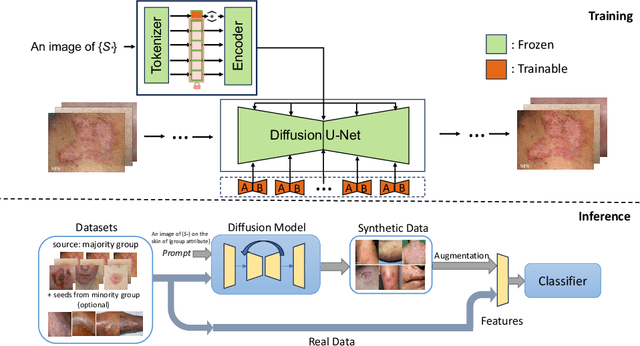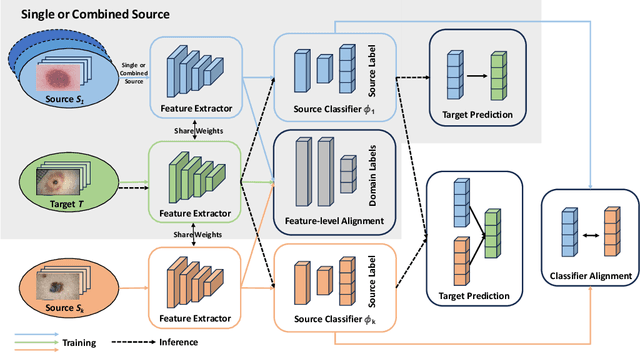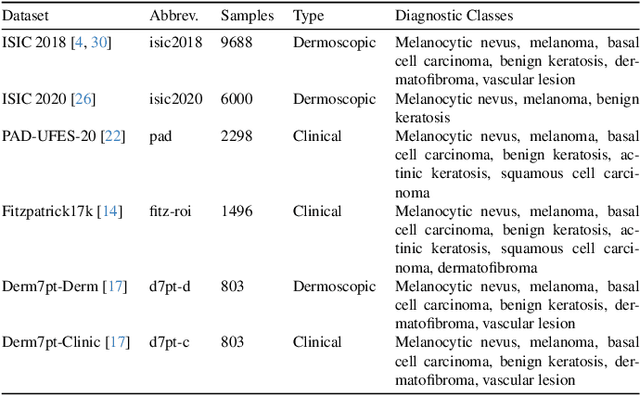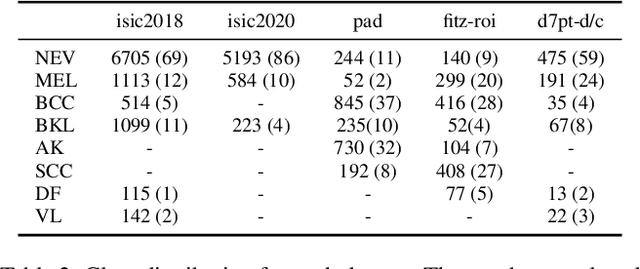Janet Wang
Enhancing Skin Disease Diagnosis: Interpretable Visual Concept Discovery with SAM Empowerment
Sep 14, 2024



Abstract:Current AI-assisted skin image diagnosis has achieved dermatologist-level performance in classifying skin cancer, driven by rapid advancements in deep learning architectures. However, unlike traditional vision tasks, skin images in general present unique challenges due to the limited availability of well-annotated datasets, complex variations in conditions, and the necessity for detailed interpretations to ensure patient safety. Previous segmentation methods have sought to reduce image noise and enhance diagnostic performance, but these techniques require fine-grained, pixel-level ground truth masks for training. In contrast, with the rise of foundation models, the Segment Anything Model (SAM) has been introduced to facilitate promptable segmentation, enabling the automation of the segmentation process with simple yet effective prompts. Efforts applying SAM predominantly focus on dermatoscopy images, which present more easily identifiable lesion boundaries than clinical photos taken with smartphones. This limitation constrains the practicality of these approaches to real-world applications. To overcome the challenges posed by noisy clinical photos acquired via non-standardized protocols and to improve diagnostic accessibility, we propose a novel Cross-Attentive Fusion framework for interpretable skin lesion diagnosis. Our method leverages SAM to generate visual concepts for skin diseases using prompts, integrating local visual concepts with global image features to enhance model performance. Extensive evaluation on two skin disease datasets demonstrates our proposed method's effectiveness on lesion diagnosis and interpretability.
From Majority to Minority: A Diffusion-based Augmentation for Underrepresented Groups in Skin Lesion Analysis
Jun 26, 2024



Abstract:AI-based diagnoses have demonstrated dermatologist-level performance in classifying skin cancer. However, such systems are prone to under-performing when tested on data from minority groups that lack sufficient representation in the training sets. Although data collection and annotation offer the best means for promoting minority groups, these processes are costly and time-consuming. Prior works have suggested that data from majority groups may serve as a valuable information source to supplement the training of diagnosis tools for minority groups. In this work, we propose an effective diffusion-based augmentation framework that maximizes the use of rich information from majority groups to benefit minority groups. Using groups with different skin types as a case study, our results show that the proposed framework can generate synthetic images that improve diagnostic results for the minority groups, even when there is little or no reference data from these target groups. The practical value of our work is evident in medical imaging analysis, where under-diagnosis persists as a problem for certain groups due to insufficient representation.
Can Domain Adaptation Improve Accuracy and Fairness of Skin Lesion Classification?
Jul 06, 2023



Abstract:Deep learning-based diagnostic system has demonstrated potential in classifying skin cancer conditions when labeled training example are abundant. However, skin lesion analysis often suffers from a scarcity of labeled data, hindering the development of an accurate and reliable diagnostic system. In this work, we leverage multiple skin lesion datasets and investigate the feasibility of various unsupervised domain adaptation (UDA) methods in binary and multi-class skin lesion classification. In particular, we assess three UDA training schemes: single-, combined-, and multi-source. Our experiment results show that UDA is effective in binary classification, with further improvement being observed when imbalance is mitigated. In multi-class task, its performance is less prominent, and imbalance problem again needs to be addressed to achieve above-baseline accuracy. Through our quantitative analysis, we find that the test error of multi-class tasks is strongly correlated with label shift, and feature-level UDA methods have limitations when handling imbalanced datasets. Finally, our study reveals that UDA can effectively reduce bias against minority groups and promote fairness, even without the explicit use of fairness-focused techniques.
 Add to Chrome
Add to Chrome Add to Firefox
Add to Firefox Add to Edge
Add to Edge